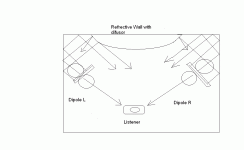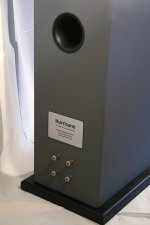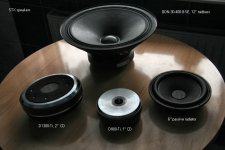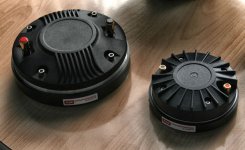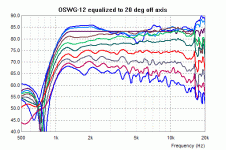in the meantime I've read an interview of You by Grzegorz Swiniarski at Frankfurt Show in 1996 for Polish "Magazyn HiFi"
funny, I read it before when it was first published but then I simply forgot it. Perhaps it was too early for me then 🙂
Now I rediscover how similar are my views to those You had expressed in that interview - about linear frequency response that is not most important, about importance of dissapearing act and off axis 3D, about working of our hearing in time domain, about importance of decor consideration etc.
all those things that finally lead me to single driver full range, to the Stereolith and then to the flooder idea, interesting
funny, I read it before when it was first published but then I simply forgot it. Perhaps it was too early for me then 🙂
Now I rediscover how similar are my views to those You had expressed in that interview - about linear frequency response that is not most important, about importance of dissapearing act and off axis 3D, about working of our hearing in time domain, about importance of decor consideration etc.
all those things that finally lead me to single driver full range, to the Stereolith and then to the flooder idea, interesting
Yes, all this ideas are very old but not considered by many at the time. Had i done an interview in the late 70th a lot of what i was saying in the 90th was already in my head as a rough scetch. I have an idea for a flooder i will build and test. It is a tube that is standing on the floor, maybe 70cm high and the top is slanted by maybe 45 °.
I will use the Scan driver and at 2m or there abouts it will reach ear height. A lot of the energy in the mid - treble will be refected by the walls and the ceiling but not much 3-D inforamtion will reach the back wall. That could be a workable first cut at the problem.
I will use the Scan driver and at 2m or there abouts it will reach ear height. A lot of the energy in the mid - treble will be refected by the walls and the ceiling but not much 3-D inforamtion will reach the back wall. That could be a workable first cut at the problem.
I have an idea for a flooder i will build and test. It is a tube that is standing on the floor, maybe 70cm high and the top is slanted by maybe 45 °.
sounds a bit like Shahinian Compass/Starter
while reading though te original thread I came to an interim conclusion that what we really need is to test the very idea by someone experienced, with good ear and measurement equipment
because the fact that many very different versions of the flooder (single way, multi way, on the floor, at the ear height and even dipole) tried by various users led to more or less satisfactory results tells us that it is first of all an idea of loudspeaker and room interface and not of a particular special speaker, in fact any small two way bookshelf coaxial like KEF UniQ or Tannoy DCC can be perfectly flooded by closing the vents and laying it on the floor with back down (actually I did it with small UniQ KEFs)
so instead of building another version I think perhaps it could be more instructive to build just a simple test enclosure similar to my own "original" flooder that is circa 30x15x30 (wxhxd) with a driver asymmetrically on flat top, as little internal volume as possible with particular driver, closed or with resistive vent
and then test its behiavour in various placements in the room - Beveridge placement that I originally advocated, then more or less in the corners, along the long wall, next to wall or away from it, directly on the floor or on stand, at ear height or any other height, more or less tilted towards the listener or not at all, with some equalizations or without and so on
what do You think?
Last edited:
Another idea i had a long time ago is to use Phantom Sources to "Flood" the room more homogeniously. Actually i have a patent on the use of Phantom Sources. The solution i show here was presented to Rick Beveridge, the son of Beveridge and he told me that this is the first innovative roomdrive he has seen since his father died. The difuser is not neccesarry. I build it and it works fine. I have another solution i build with electrostats that is even more surprising. People that listened to it where quite shocked and could not understand what was going on but i remain silent on that until i can show it in public.
Attachments
Joachim, have you tried the same with CD waveguides? You can safely EQ to you taste. BTW: Duke uses controlled-pattern offset bipole.
My only experience with waveguides is the DXT tweeter from Seas. With equalisation i got fantastic off axis response. I did not try much with Bipole ether. Most "Omni" speakers i listened too have very weak focus. I talked to Earl Geddes on a show and watch his work. Thats it in a nutshell so far.
P.S. The original Manger "Lens" i used is a bipole too and did not suffer from weak fokus so i know it can be done. Radiation pattern is one of the most overlooked features of a speaker and surely needs more scientific work to be put in.
P.S. The original Manger "Lens" i used is a bipole too and did not suffer from weak fokus so i know it can be done. Radiation pattern is one of the most overlooked features of a speaker and surely needs more scientific work to be put in.
DXT increase directivity to match bigger woofers like CA22RNY. Both gives very nice and clear sound even above 90dB. I only listened in near field as my friend Christopher already made a pair (see below picture of "Hurricane").
I've been to Manger house three years ago. Herr Manger uses bipole radiation with his Zerobox+Sidekick. Sound perspective was stable in the room and SPL limited. We had very nice conversation.
If we look for a universal loudspeaker that will satisfy both camps then it's simple to install rear waveguide plus ground woofer. With bipolar you can make a switch and decide how much your room would you like to hear. With horns phantom image collapses very quickly if you move head - I hope CD waveguide is much better.
I've been to Manger house three years ago. Herr Manger uses bipole radiation with his Zerobox+Sidekick. Sound perspective was stable in the room and SPL limited. We had very nice conversation.
If we look for a universal loudspeaker that will satisfy both camps then it's simple to install rear waveguide plus ground woofer. With bipolar you can make a switch and decide how much your room would you like to hear. With horns phantom image collapses very quickly if you move head - I hope CD waveguide is much better.
Attachments
Nice picture ! I stay in contact with Daniela much. The speaker looks good.
I know that problem from horns. Most of them have to be listened too from far away or the stage goes into pieces.
I know that problem from horns. Most of them have to be listened too from far away or the stage goes into pieces.
Another idea i had a long time ago is to use Phantom Sources to "Flood" the room more homogeniously. Actually i have a patent on the use of Phantom Sources. The solution i show here was presented to Rick Beveridge, the son of Beveridge and he told me that this is the first innovative roomdrive he has seen since his father died.
very interesting, the system with convex reflector looks a lot like JBL Paragon
BTW frankly speaking I cannot imagine better theoretically grounded speaker placement method then the method proposed by Harold Beveridge
I have another solution i build with electrostats that is even more surprising. People that listened to it where quite shocked and could not understand what was going on
again, I find it difficult to imagine anything more surprising than flooder in Beveridge placement, from the perspective of the listener there is literally no speaker in sight in the room - just the 3d sound hologram
well, perhaps the stereolit is even more surprising - the typical question I was asked when I had it in my house was "where is the other speaker?!" 😉
best,
graaf
Last edited:
for me it looks overly complicated, what is good in it?
Yes, the Beveridge is an amasing solution. I heard it ones in modified form in Dr. Peter Forsells listenig romm and it could even play very load and had good treble extension.
I found the original always a bit slow and tired. I also own a pair and i have financed a project to make a direct drive tube amp of modern construction. I have to check how far my gusy are. The soundstage of the Beveridge is the best i heard so far. Very deep, wide and focussed.
On the Frickelfest there was a guy called Dieter that played a big Linaeum tweeter. I found the bass cabinet he designed a bit boomy but midrange treble was very interesting.
Here is a link to Airfoil, the follow up company. Ufortunately they do not seem to be in business any more.
Airfoil Lo ud Speakers
I found the original always a bit slow and tired. I also own a pair and i have financed a project to make a direct drive tube amp of modern construction. I have to check how far my gusy are. The soundstage of the Beveridge is the best i heard so far. Very deep, wide and focussed.
On the Frickelfest there was a guy called Dieter that played a big Linaeum tweeter. I found the bass cabinet he designed a bit boomy but midrange treble was very interesting.
Here is a link to Airfoil, the follow up company. Ufortunately they do not seem to be in business any more.
Airfoil Lo ud Speakers
Trust me Graaf, my solution is surprising too. No speakers in sight. Actually they hang flat on the ceeling when the are not in action. It´s a kinetic system. I am waiting for a friend to finish his 110dB direct drive electrostats. I listened to his modified Stax headphone and was mesmerised. Incredible extended in the bass and very good dynamics. A widerange refference.
But this is all expensive High End stuff and does not fit your proposal of a unversal, affordable solution. Anyway, your ideas inspire me. We need something good for the masses.
But this is all expensive High End stuff and does not fit your proposal of a unversal, affordable solution. Anyway, your ideas inspire me. We need something good for the masses.
for me it looks overly complicated, what is good in it?
You put well defined sound pattern into reverberant field which creates pleasant sound in a concert hall. CD waveguide lowers reflections over 10dB which helps a lot in "small rooms". It's not a problem to make dual horn cab - I designed my cab as two interchangeable halves so it can be modified, unscrewed many times etc. Compression drivers are much cheaper than SS tweeters and the sound is life like 🙂
I haven't listen to CD waveguide yet so I can't comment more. Give me one month 😀
Last edited:
I use cost effective Polish 1 inch STX D800-Ti and D1300-Ti (2"). I wish to have modern compression driver with naked phase plug, without duct that resonate with waveguides. OSWG when equalized to let say 20 deg has nice pattern. We can smooth on axis response with larger roundover.
Attachments
Last edited:
Haven't tried them yet, they are too expensive (134.00 €), in China similar driver costs $10, STX is $30. BMS 4538 is worth money IMHO. Driver for waveguide should have straight duct - zero degrees throat angle, plane wave.
Replacement membrane with coil for STX is about $10 so you can easily experiment with back chamber, dipole configuration etc.
Anyway, your ideas inspire me. We need something good for the masses.
honestly I think that what the masses (by which I mean ordinary music lovers) really need from perspective of serious music listening purposes (as opposed to just complementing a TV system) is a good monophonic corner reproducer
this is becasue it is almost impossible to properly set up a stereo system in most living rooms and this in turn is because a comfortable living room arrangement is almost always asymmetrical, but on the other hand at least one corner usually remains empty
an audiophile can arrange a room specifically for audio purposes and have the Beveridge setup which I believe is the best (with the flooder or with any other compatible speaker) but this is not the case of ordinary music lover
the flooder is a good candidate for mono all rounder
my own experience, and also of other users like Elias, shows that even plain "2-way monopole in ceiling firing arrangement" has good potential:
http://www.diyaudio.com/forums/multi-way/121385-loudspeakers-room-system-108.html#post2133755
what is most important the sound is not localized in the loudspeaker (sic!) and the sweet spot literally covers the whole room:
* a little bit surprisingly I cannot localise the speaker at the floor, it never happened
* there is no sweet spot in the room. If I stay more than 2 meters from the speaker the sound is the same everywhere.
it's true that it has to be EQ-ed but that is not a slightest problem
it's also true that it obscures some small detail but that is also not a problem for ordinary music lover, she/he has no audiophile fetish on small detail 😉
best regards,
graaf
Last edited:
